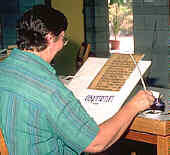

If you are looking at this page without frames, there is more information about medieval writing to be found by going to the home page (framed) or the site map (no frames).
| What is Paleography? | ||
 |
||
| Paleography is the art of analysing and reading handwriting. Some would call it a science, and to a degree it has acquired a veneer of scientific style, classification and ordering, but ultimately it involves one human individual attempting to understand the unique efforts at communication of another. This is fundamentally an art, with some scientific props. | ||
| Paleography functions at different levels. At its most basic, it is a decoding process which allows a modern student or researcher to read what someone at an earlier time has written, even though the communication code has changed over the centuries. This is the level at which many practical researchers are quite happy to operate. They need to use paleography, not to study it. | ||
| Paleography is history in itself. Changes to styles and form of writing over the centuries reflect historical and social change. The content and style of manuscripts mirror the changing concerns of society. The history of writing is a major component of our cultural heritage. Writing as a craft and writing as a communication skill are inseparable in our cultural development. | ||
| Paleography as a science can be used for intricate historical tracing. Analyses of the precise mode of delineation of letters, the identification of local script styles or individual scribal hands and the intricacies of punctuation and abbreviation can be used to trace influences across time and space, and even to trace the movements of individuals. It’s fiddly work, but somebody has to do it. (eg. Bishop 1960) | ||
| Paleography is the precursor to an active and practical skill, calligraphy. Producers of fine hand lettered works study the techniques of the past to emulate them, or develop from them. The art of manuscript is not dead, but it is now confined to a specialised corner of our cultural universe. (Drogin 1980) |  |
|
| A trained calligrapher copies from a medieval model at a Paleography School held at the University of Tasmania in 1996. | ||
| If you go along to your library shelves and take down a book with the word “paleography” in the title, you may find it a difficult read. It may be full of intricate detail and minutiae and long verbose explanations. That is the coal face of research. In any field of academia the intimate details of research can seem like the fixations of an obsessive-compulsive. Take a few steps back for a longer view and discover a rich vein of our history and heritage. | ||
|
If you are looking at this page without frames, there is more information about medieval writing to be found by going to the home page (framed) or the site map (no frames). |
||